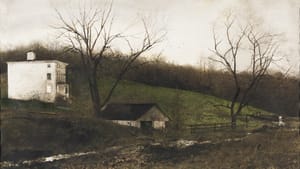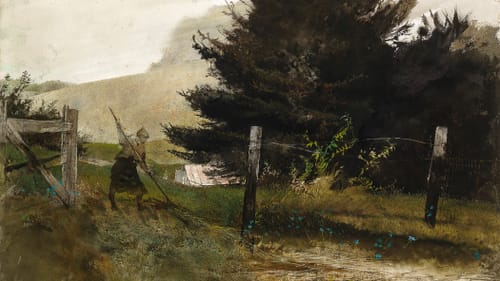Stay in the Loop
BSR publishes on a weekly schedule, with an email newsletter every Wednesday and Thursday morning. There’s no paywall, and subscribing is always free.
New windows on Wyeth’s world
Brandywine Museum of Art presents Andrew Wyeth at Kuerner Farm: The Eye of the Earth

The reclusive, prodigious Andrew Wyeth (1917-2009), one of America’s most famous and polarizing artists, can be discovered anew thanks to the Brandywine Museum of Art’s Wyeth Study Center, which opened in 2022. Exhibitions here draw on thousands of never-before-seen works, including wildly gestural watercolors, abstract pieces, and surprises like a recently discovered late series imagining his own funeral. If you haven’t seen a recent Wyeth show, you haven’t seen Wyeth.
In 2023, the Brandywine mounted Andrew Wyeth: Home Places, highlighting favored locations in and around the artist’s houses, studios, and neighbors’ properties in Chadds Ford, Pennsylvania, and Cushing, Maine. In 2024, Up East focused solely on Wyeth’s realm in Maine. Now, Andrew Wyeth at Kuerner Farm: The Eye of the Earth zooms in even more tightly on a single farm in Chadds Ford, owned by German immigrants Karl and Anna Kuerner.
All around “the eye of the earth”
From the nearly 1,000 artworks Wyeth made at Kuerner farm, 44 were chosen for this exhibition by curators William Coleman (of the Brandywine) and Allison Slaby (of Winston-Salem’s Reynolda House Museum of American Art). The works here date from 1933 to 2001, most in watercolor, drybrush watercolor, and egg tempera. Two drawings are also included; one of them, First drawing (1971), is Wyeth’s earliest-known sketch of muse Helga Testorf, who came to America in 1959 and began working for the Kuerners in 1970.
The show’s title comes from Wyeth’s own words about the locale: “the rich landscape and the lucid pond looking almost like the eye of the earth reflecting everything in creation.” A watercolor on display, Farm Pond, Study for Brown Swiss (1957), depicts the little pond. Fittingly, almost every artwork in the exhibition acts as a window to another world.
Famous paintings are well-represented, including two that are rarely lent for exhibition: the temperas Karl (1948) and Groundhog Day (1959). The iconic and very weird Snow Hill (1989) is on view, along with watercolor greats like Evening at Kuerners (1970), Wolf Moon (1975), and Loden Coat (1978). Karl, like other portraits of the Kuerner patriarch, simmers with potential violence: Kuerner was a farmer raising animals for slaughter and a veteran of World War I who had been a machine gunner for the German military. Cornflowers (1986), by contrast, is a bucolic portrait of Anna Kuerner. Although her physical frailty is conveyed by the figure’s translucence, the tiny pops of blue flowers in the picture offer a sense of hope.

As viewers enter the exhibition space on the museum’s third floor, two dramatic paintings immediately catch the eye. Black Hunter (1938) is a portrait of Wyeth’s childhood friend David Lawrence, confronting the viewer with an unreadable expression. Lawrence was a member of the Black community around Lydia “Mother” Archie’s A.M.E. Church. Nearby, Woodshed (1944) zeroes in on two birds hung by their feet against pale boards. Stark shadows cast by the roof’s overhang and the bird’s bodies add to the painting’s vivid effect. Wall texts offer background on nearly every artwork, and a video situates the farm and Wyeth’s response to its people, animals, and places. A vitrine holds ephemera, including Karl Kuerner’s World War I helmet.
Savoring the enigmas
Throughout the show, there is much to savor in the studies and watercolors, interspersed by the enigmatic paintings. In the studies, we see Wyeth’s process: violence, speed, and imperfections like a dog’s paw print leading us to imagine the picture-strewn studio floor. In Young Bull (1960), the animal’s head is defined by highly detailed marks, while the hind legs may have been smudged in with fingertips. On the left, the background is gouged with heavy horizontal strokes.
An exhibition catalogue is available, with essays from the curators and contributions by Wyeth Study Center collection manager Karen Baumgartner and artist James Welling. Andrew Wyeth at Kuerner Farm was on view at Reynolda House Museum earlier this year and, after its run at the Brandywine, travels to its final venue, Cummer Museum of Art and Gardens in Jacksonville, Florida.
What, When, Where
Andrew Wyeth at Kuerner Farm: The Eye of the Earth. Through September 28, 2025, at the Brandywine Museum of Art, 1 Hoffman’s Mill Road, Chadds Ford. $8-$20 (free for members and children 5 and under). (610) 388-2700 or brandywine.org.
Accessibility
The entire museum, including the Millstone Café, is wheelchair accessible, with accessible parking, a barrier-free entrance, and available wheelchairs. Service animals are welcome.
Sign up for our newsletter
All of the week's new articles, all in one place. Sign up for the free weekly BSR newsletters, and don't miss a conversation.

 Emily Schilling
Emily Schilling